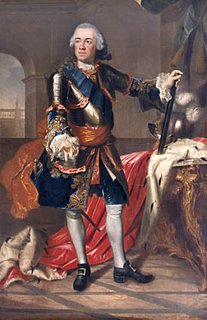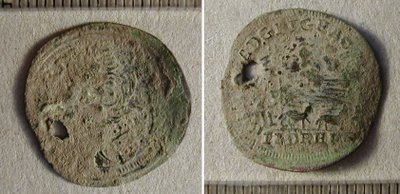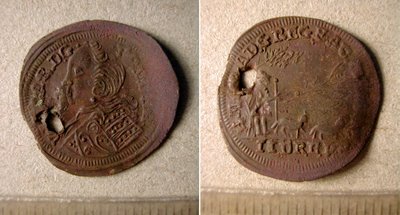William's Counter
 I made an unexpected historical acquaintance today: William IV of Nassau-Dietz, prince of Orange (1711-1751), or, as his mum called him, Willem Karel Hendrik Friso.
I made an unexpected historical acquaintance today: William IV of Nassau-Dietz, prince of Orange (1711-1751), or, as his mum called him, Willem Karel Hendrik Friso.Having recently found a mysterious little coin during fieldwork in Östergötland, I sent pictures of it to the good people at the Royal Coin Cabinet in Stockholm. I couldn't make head or tail of the thing myself. Seemingly random sequences of neoclassical lettering and clumsy depictions of tiny horses? And it wasn't in very good shape either.


Monica Golabiewski Lannby identified the piece in the blink of an eye. It isn't actually a coin, it's a counter used on a kind of 18th century abacus. Writes Monica:
It's a brass counter, a jeton, struck for William Charles, prince of Orange. On the averse one can see his bare head and the legend: WIL CAR D G PRI V ORA. On the reverse is a farmer wearing a short coat and a hat, holding a stick, two dogs in front of him, a field above and to the right. Above: AMOR AD GREG FAC ME DUC, below: I I D RE PF, which means Iohann Iacob Dietzel who was countermaster 1711-1748. RE PF means Rechenpfennig [i.e. counter].Willem was elected stadtholder of the Netherlands in 1747, but I guess the counter may have been struck long before that while he was still a local ruler.
I wonder how this thing ended up in Östergötland. It wouldn't buy anything even in the Netherlands, and certainly not in Sweden. It's perforated for a string, so I suppose someone may have taken it home as a souvenir and worn it as an ornament. When found, it was folded into a strip of thin copper sheet. Technically, this would qualify the find as a tiny hoard.
Update 3 May: Professor Kenneth Jonsson tells me that Dietzel was not in fact Willem's employee, nor did he live in the Netherlands. The centre of counter production at the time was Nuremberg, and that's where Dietzel worked. So, why did he make counters with Willem's image? Actually, he made counters depicting pretty much anyone of the era's celebrities.
Update 4 May: Adds Monica, "During the 18th century the counting method was gradually abandoned, but counters were still manufactured and instead used more as chits for card games. They are very common in Swedish finds."
[More blog entries about history, numismatics, coins, Netherlands, Sweden; historia, mynt, numismatik, Nederländerna, Östergötland.]



0 Comments:
Post a Comment
<< Home